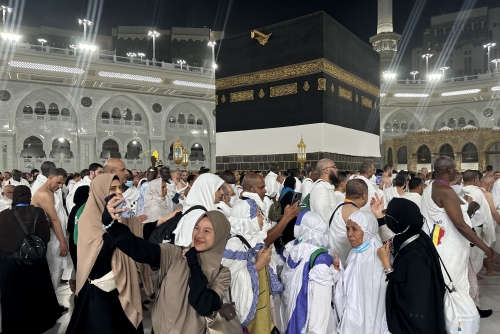AI, drones, cameras to keep hajj pilgrims safe
AFP | Mecca
Email: mail@newsofbahrain.com
Working day and night in front of maps, screens and seemingly endless data, Saudi officials have harnessed artificial intelligence to help manage the million-strong sea of pilgrims during the hajj.
The technology has proven pivotal to track the overwhelming amount of footage from more than 15,000 cameras in and around the holy city of Mecca.
The systems are tuned to spot abnormal crowd movements or predict bottlenecks in foot traffic -- a potential life-saver at a packed event with a history of deadly stampedes.
Software is also used to help guide more than 20,000 buses deployed to transport pilgrims between holy sites during one of the world’s biggest annual religious gatherings.
It is all part of the tech arsenal that Saudi Arabia is deploying as 1.4 million faithful from across the globe descend on Mecca and its surrounds.
“In our traffic control room, we use specialised cameras that have AI layers to analyse movements, crowded areas” and predict behaviours, said Mohamed Nazier, chief executive officer for the General Transport Centre at the Royal Commission for Mecca.
The centre has a main control room in Mecca filled with screens and maps, where staff use high-tech tools including AI for round-the-clock monitoring. About a dozen staff members sit in rows before desktop computers with a large display at the front, zooming in on crowd movements around the holy sites.
On hillsides nearby, cameras that resemble little white robots film buildings, roads and pathways along the hajj route, which winds more than 20 kilometres (12 miles) between Mecca and Mount Arafat. Nazier said the constant monitoring is aimed at averting traffic collisions with pedestrians on crowded routes while also making sure there are buses available to minimise walking time in the desert heat.
‘Our eye on the ground’
With its cutting-edge technology, “the control room is our eye on the ground,” said Mohammed al-Qarni, who oversees the hajj and the year round umrah pilgrimage at the transport centre.
Artificial intelligence helps to determine “the flow on the (roads to the holy sites), and detects emergency situations even before they occur”, he told AFP, adding that the technology can help assess the number of people in a single place. Cameras and AI can estimate if a site has reached maximum capacity, allowing authorities to divert the flow of pilgrims, Qarni said.
During the holy month of Ramadan this year, the system spotted when the Grand Mosque had reached full capacity.
“The flow to the Haram (Grand Mosque) was stopped and the process cont rolled,” he said.
Related Posts

